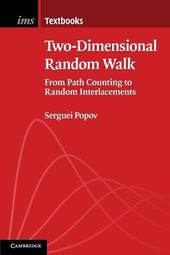
|
Two-Dimensional Random Walk: From Path Counting to Random Interlacements
Paperback / softback
Main Details
| Title |
Two-Dimensional Random Walk: From Path Counting to Random Interlacements
|
| Authors and Contributors |
By (author) Serguei Popov
|
| Series | Institute of Mathematical Statistics Textbooks |
|---|
| Physical Properties |
| Format:Paperback / softback | | Pages:200 | | Dimensions(mm): Height 228,Width 151 |
|
| Category/Genre | Calculus and mathematical analysis
Probability and statistics |
|---|
| ISBN/Barcode |
9781108459693
|
| Classifications | Dewey:519.282 |
|---|
| Audience | | Professional & Vocational | |
|---|
| Illustrations |
Worked examples or Exercises
|
|
Publishing Details |
| Publisher |
Cambridge University Press
|
| Imprint |
Cambridge University Press
|
| Publication Date |
18 March 2021 |
| Publication Country |
United Kingdom
|
Description
The main subject of this introductory book is simple random walk on the integer lattice, with special attention to the two-dimensional case. This fascinating mathematical object is the point of departure for an intuitive and richly illustrated tour of related topics at the active edge of research. It starts with three different proofs of the recurrence of the two-dimensional walk, via direct combinatorial arguments, electrical networks, and Lyapunov functions. After reviewing some relevant potential-theoretic tools, the reader is guided toward the relatively new topic of random interlacements - which can be viewed as a 'canonical soup' of nearest-neighbour loops through infinity - again with emphasis on two dimensions. On the way, readers will visit conditioned simple random walks - which are the 'noodles' in the soup - and also discover how Poisson processes of infinite objects are constructed and review the recently introduced method of soft local times. Each chapter ends with many exercises, making it suitable for courses and independent study.
Reviews'An excellent and inspiring introduction to simple random walk and random interlacements, in transient and recurrent cases. With its careful and original selection of topics, the reader will soon grasp the general picture and main ideas though to quite advanced material. Each chapter has a great selection of exercises with hints and solutions. This book is primarily designed for self-study, but it can also be used for a graduate course on Markov chains or Poisson processes.' Francis Comets, Universite de Paris '... a well-written summary of the subject ... Highly recommended.' M. Bona, Choice Connect
|